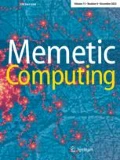Abstract
The continuous non-revisiting genetic algorithm (cNrGA) uses the entire search history and parameter-less adaptive mutation to significantly enhance search performance. Storing the entire search history is natural and costs little when the number of fitness evaluations is small or moderate. However, if the number of evaluations required is substantial, some memory management is desirable. In this paper, we propose two pruning mechanisms to keep the memory used constant. They are least recently used pruning and random pruning. The basic idea is to prune a unit of memory when the memory threshold is reached and some new search information is required to be stored, thus keeping the overall memory used constant. Meanwhile, both pruning strategies naturally form parameter-less adaptive mutation operators. A study is carried out to evaluate the impact on performance caused by loss of search history information. Experimental results show that (1) both strategies can maintain the performance of cNrGA, up to the empirical limit when 90 % of the search history is not recorded, (2) cNrGA and its variants with constant memory outperform the real-coded genetic algorithm and the standard particle swarm optimization. By pre-extracting all the current prune-able history information and storing them into a list, namely, to-prune-list, the overhead of both pruning strategies becomes small. This suggests that cNrGA can be extended to use in situations when the number of fitness evaluations is much larger than before with no significant effect on statistical performance. This widens the applicability of cNrGA to include more practical problems that require larger number of fitness evaluations before converging to the global optima.








Similar content being viewed by others
References
Wolpert DH, Macready WG (1997) No free lunch theorems for optimization. IEEE Trans Evol Comput 1(1):67–82
Davis L (ed) (1991) Handbook of genetic algorithms, vol 115. Van Nostrand Reinhold, New York
Friedrich T, Hebbinghaus N, Neumann F (2007) Rigorous analyses of simple diversity mechanisms. In: Proceedings of the 9th annual conference on genetic and evolutionary computation (GECCO). ACM, New York, pp 1219–1225
Ronald S (1998) Duplicate genotypes in a genetic algorithm. In: Proceedings of the IEEE world congress on computational intelligence (WCCI), pp 793–798
Povinelli RJ, Feng X (1999) Improving genetic algorithms performance by hashing fitness values. In: Proceedings of the artificial neural networks in engineering (ANNIE), pp 399–404
Kratica J (1999) Improving performances of the genetic algorithm by caching. Comput Artif Intell 18(3):271–283
Yuen SY, Chow CK (2009) A genetic algorithm that adaptively mutates and never revisits. IEEE Trans Evol Comput 13(2):454–472
Glover F, Laguna M (1997) Tabu search. Kluwer, Norwell
Chow CK, Yuen SY (2010) Continuous non-revisiting genetic algorithm with random search space re-partitioning and one-gene-flip mutation. In: Proceedings of the IEEE congress on evolutionary computation (CEC) , Barcelona. doi:10.1109/CEC.2012.6252926
Chow CK, Yuen SY (2012) Continuous Non-revisiting Genetic Algorithm with Overlapped Search Sub-region. In Proceedings of the IEEE congress on evolutionary computation (CEC), Brisbane, QLD, p 1–8. doi:10.1109/CEC.2010.5586046
Yuen SY, Chow CK (2008) A non-revisiting simulated annealing algorithm. In: Proceedings of the IEEE congress on evolutionary computation (CEC), pp 1886–1892
Chow CK, Yuen SY (2008) A non-revisiting particle swarm optimization. In: Proceedings of the IEEE congress on evolutionary computation (CEC), pp 1879–1885
Du J, Rada R (2012) Memetic algorithms, domain knowledge, and financial investing. Memet Comput 4(2):109–125
Young CN, LeBrese C, Zou JJ, Leo CJ (2013) A robust search paradigm with enhanced vine creeping optimization. Eng Optim 45(2):225–244
Akay B, Karaboga D (2012) A modified artificial bee colony algorithm for real-parameter optimization. Inf Sci 192:120–142
Jadon SS, Bansal JC, Tiwari R, Sharma H (2015) Accelerating artificial bee colony algorithm with adaptive local search. Memet Comput 7(3):215–230
Gandomi AH, Yang XS (2012) Evolutionary boundary constraint handling scheme. Neural Comput Appl 21:1449–1462
Wang Y, Li HX, Huang T, Li L (2014) Differential evolution based on covariance matrix learning and bimodal distribution parameter setting. Appl Soft Comput 18:232–247
Wang Y, Wang BC, Li HX, Yen GG (2015) Incorporating objective function information into the feasibility rule for constrained evolutionary optimization. IEEE Trans Cybern (in press). doi:10.1109/TCYB.2015.2493239
Chu W, Gao X, Sorooshian S (2011) Handling boundary constraints for particle swarm optimization in high-dimensional search space. Inf Sci 181:4569–4581
Zambrano-Bigiarini M, Clerc M, Rojas R (2013) Standard particle swarm optimisation 2011 at CEC-2013: a baseline for future PSO improvements. In: Proceedings of the IEEE congress on evolutionary computation (CEC), pp 2337–2344
Hansen N (2006) The CMA evolution strategy: a comparing review. In: Proceedings on towards a new evolutionary computation, pp 75–102
Hansen N (2011) The CMA evolutionary strategy: a tutorial. In: Technical report. http://www.lri.fr/~hansen/cmatutorial.pdf. Accessed 14 June 2015
Mack CA (2011) Fifty years of Moore’s law. IEEE Trans Semicond Manuf 24(2):202–207
Lou Y, Yuen SY (2015) Non-revisiting genetic algorithm with constant memory. In: Proceedings of the IEEE systems, man, and cybernetics (SMC), pp 1714–1719
Eshelman LJ, Schaffer JD (1992) Real-coded genetic algorithms and interval-schemata. In: Proceedings of the international conference on genetic algorithms (ICGA), pp 187–202
Lihu A, Holban S, Popescu O-A (2012) Real-valued genetic algorithms with disagreements. Memet Comput 4(4):317–325
Heris SMK (2015) Implementation of real-coded genetic algorithm in MATLAB. http://www.yarpiz.com. Accessed 23 Aug 2015
Chow CK, Yuen SY (2011) An evolutionary algorithm that makes decision based on the entire previous search history. IEEE Trans Evol Comput 15(6):741–769
Leung SW, Yuen SY, Chow CK (2012) Parameter control system of evolutionary algorithm that is aided by the entire search history. Appl Soft Comput 12(9):3063–3078
www.ee.cityu.edu.hk/~syyuen/Public/Code.html. Accessed 28 Dec 2015
Liang JJ, Qu B-Y, Suganthan PN, Hernández-Díaz AG (2013) Problem definitions and evaluation criteria for the CEC 2013 special session and competition on real-parameter optimization. In: Technical report 2012, Computational Intelligence Laboratory, Zhengzhou University, Zhengzhou and technical report, Nanyang Technological University, Singapore
Karafotias G, Hoogendoorn M, Eiben AE (2014) Parameter control in evolutionary algorithms: trends and challenges. IEEE Trans Evol Comput 19(2):167–187
Sedgewick R (2002) Algorithms in Java, parts 1–4. Addison-Wesley, Boston
Knuth DE (1998) The art of computer programming: sorting and searching. Pearson Education, London
Acknowledgments
The work described in this paper was supported by a grant from the Research Grants Council of the Hong Kong Special Administrative Region, China (Project No. CityU 125313). We thank Dr. Chi Kin Chow for suggesting that pruning can be done randomly on the discrete version of NrGA.
Author information
Authors and Affiliations
Corresponding author
Appendix
Appendix
Rights and permissions
About this article
Cite this article
Lou, Y., Yuen, S.Y. Non-revisiting genetic algorithm with adaptive mutation using constant memory. Memetic Comp. 8, 189–210 (2016). https://doi.org/10.1007/s12293-015-0178-6
Received:
Accepted:
Published:
Issue Date:
DOI: https://doi.org/10.1007/s12293-015-0178-6




